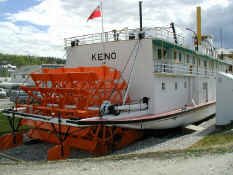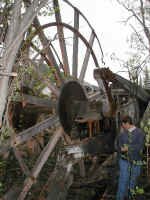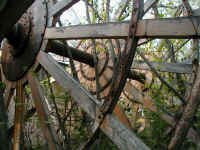Stern-wheelers of the Far North
During their heyday there were some 35O stern-wheelers on the Yukon River and other, major, rivers in the North. Defined as a paddle-wheel steamer having a stern wheel instead of side wheels, these massive wooden vessels plied Northern rivers for almost 100 years, hauling supplies, equipment, ore and passengers.

SS Klondike, Whitehorse, Yukon
Stern-wheelers were first introduced to the Yukon River in 1866. Saddle wheels churning, boilers chugging, they moved up and down the river, from after breakup until just before the river froze for the winter.
Yukon stern-wheelers were patterned after the stately Missouri River boats, with flat hulls to keep up speed and "hog posts" on the upper decks to prevent twisting and to haul the ships over shallow points along the river. Because the boats were often lost to snags, rocks, sandbars, ice floes, rapids and other river hazards, they had to be economical to build and repair, so they were constructed from native Douglas fir, cedar and pine.
The typical vessels were about 170 feet long, 35 feet wide and could carry up to 250 tons 0f cargo. They were run by locomotive-type boiler engines, which cost about $2 per mile to operate, burning about 120 cords of wood on a trip from Whitehorse to Dawson. Wood camps sprang up along the river to provide fuel for the stern-wheelers during their journey.
Airplanes and all-weather roads eventually ended the stern-wheeler's supremacy.
Bridges built along the highway to Dawson City were too low to accommodate the old river steamers, and by 1955 all steamers had been beached.
Today, only 2 of these grand old riverboats survive in the Yukon and both are Parks Canada National Historic Sites: the SS Klondike in Whitehorse, and the SS Keno in Dawson City. The hundreds of others had been lost. Some were sold and moved out of the North. Others were wrecked on the river. One of the worst steamboat disasters on the Yukon River occurred on Sept. 25, 1906, when the paddle-wheeler Columbia blew up and burned, killing 6 men onboard, after a crew member accidentally fired a shot into a cargo of gunpowder. The SS Tutshi (too-shy) survived to become a historic site in Carcross, until she burned to the ground in July 1990.
| The SS Keno was the last steamer to run the Yukon River. In 1960, she sailed from Whitehorse to her final resting place on the riverbank in Dawson City. The 130-foot SS Keno was built in Whitehorse in 1922 by the British Yukon Navigation Company (BYNC). She was used to transport silver, lead and zinc ore from the Mayo District to Stewart. |  |
The SS Klondike was built in 1929 by BYNC. The vessel was the largest on the Yukon, had a cargo capacity 50 percent greater than previous boats, and could carry over 30 tons. She ran aground in 1936 at the confluence of the Teslin and Yukon rivers. Salvaged parts were used to construct a new ship—the second SS Klondike—that was almost identical to the first.
The Klondike carried mail, general supplies, passengers and silver lead ore along the-460-mile route between Whitehorse and Dawson City until 1955, when she was retired. Donated to the Canadian government, the SS Klondike was moved through the center of Whitehorse to where it now rests on the west bank of the Yukon near the Robert Campbell Bridge in Whitehorse.
In 1974 a spectacular fire destroyed the sternwheelers that were in dry dock in Whitehorse. These were the Casca and Whitehorse. For detail on the ships and the fire that destroyed them read the article and the accompanying photos on Explore North.

